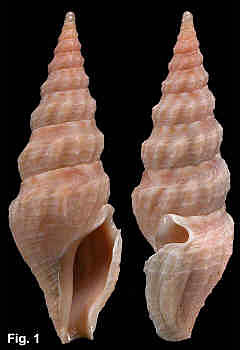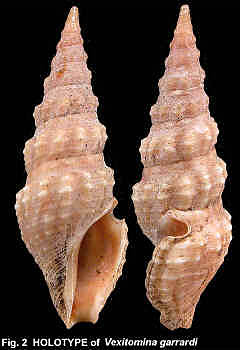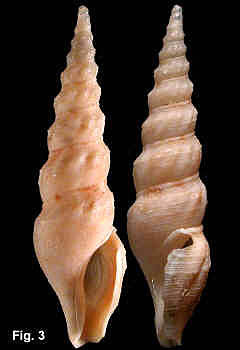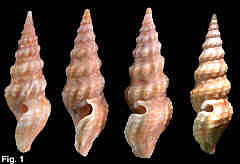|
|
|
|
|
Vexitomina coxi (Angus, 1867) Description: Whorls concave above periphery, straight or slightly concave below. Axial sculpture of solid oblique ribs from shoulder to lower suture, 12 or 13 on penultimate whorl. Spiral sculpture of 10-20 spiral cords per whorl, the strongest 2 or 3 creating weak spirally elongate nodules when crossing axial ribs. Body whorl with about 4 spiral rows of nodules . Columella smooth, with callus pad at upper end; outer lip thin, with rounded triangular shaped sinus adjoining suture. Colour fawn, sometimes with irregular dark brown patches below suture. Size: Up to 33 mm in length, typically about 20-25 mm. Distribution: Endemic to Australia; Fraser Is, Queensland, to Victoria and Tasmania. Habitat: Taken in 9-278 m, but most specimens from shallower than 150 m. Moderately common. Comparison: This species is very similar in shape and sculpture to Vexitomina torquata, but can be distinguished by three features;
Synonymy: Vexitomina garrardi Laseron, 1954 (NEW SYNONYM) Remarks: V. coxi varies considerably in shell width and in strength of sculpture. Vexitomina garrardi Laseron, 1954 has been applied to a broad form with strong sculpture (Holotype, Fig. 2). A narrow, deep water form from off Stradbroke Island is shown in Fig. 3. The shape of the sinus and the strength of the callus pad changes as the shell matures. Fig. 4 shows the changes, from a juvenile shell with no callus pad on the left, to a mature specimen with strong callus pad on the right. Fig. 1: 5.6 km east of North Head, NSW, in 66 m (C.169544) Fig. 2: HOLOTYPE of Vexitomina garrardi; Twofold Bay, NSW (C.103506) Fig. 3: Off Point Lookout, Stradbroke Is., Queensland, in 234 m (C.396713) Fig. 4: Development of callus pad and sinus with maturity (C.unregistered)
|



